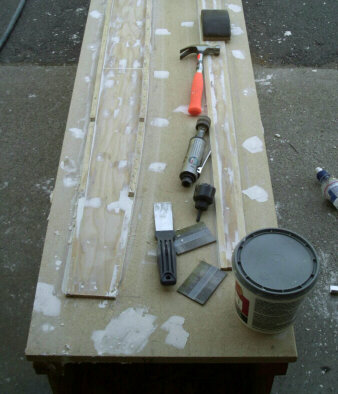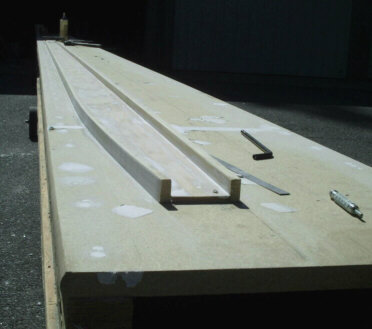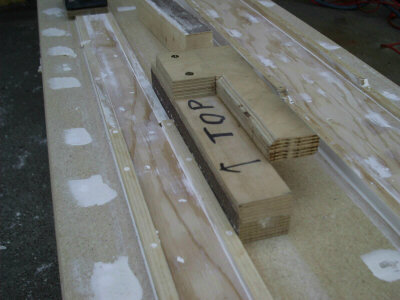
I spent my shop hours this weekend cleaning up the wing spar plugs. I'm using fast-drying vinyl spackle as a filling agent to fill in all of the gaps, dings, and nail holes. Later, I'll give the whole thing a coat of urethane finishing varnish and send it off to the molding guy.
One of the things I've noticed about the spar plug is that it's going fine, but it's not going the way I expected. The part I thought would be the hardest, maintaining specified dimensions and tolerances, has shown itself to be a complete no-brainer. Everything I measure is within a few thou of what I'm looking for. But the part I didn't even think about, achieving smooth surface conditions, has proven to be the most time consuming. Go figure.
The picture below shows the butt end of the short C-section. If you look carefully, you can see the four places where the carbon elements step down. The white patches are spackle, before sanding. You can tell you're doing spackle right when you sand away about 95% of what you apply.

The photo below shows the butt end of the long C-section. Note that the curve is the mirror image of the short section. Also note the smoothness and straightness.

The photo below shows my secret weapon - the 9" draft sander. This is a sanding block with a handle on it that I use to sand the semivertical edges of the plug. I say semivertical because the have 1.25 degrees of draft to them so that the mold will release from the plug and so the parts will release from the mold. Anyhow, the sanding block is specially cut wit the 1.25-degree draft angle. The white spots on the spar cap and web areas are where there are finishing nails covered by spackle. The larger white areas on the tabletop surface are where I haven't yet sanded away the surplus spackle that I applied to the screws that secure the tabletop to the structural joists.

Well, that's it for that weekend. I spent most of the time working, not taking photos. I figure one more session of finish work, one more session to varnish it, and it goes off to the molding guy.
page updated 3 June 2002 all text and graphics copyright (c) 2002 HP Aircraft, LLC